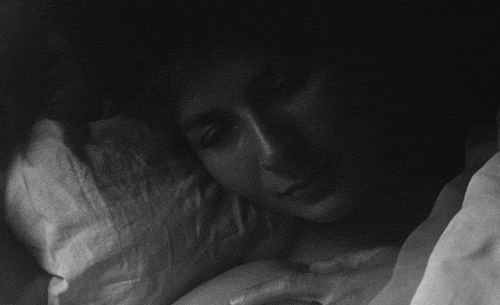| Fig. 1: La Jetée Poster. |
 |
| Fig. 2: The woman from the man's memory. |
| Fig. 3: The man dies. |
 |
| Fig. 4: The woman in bed. |
| Fig. 5: An assassin sent to kill the man. |
Marker has only chosen the most important images in this film to show mood and atmosphere. It imitates a storyboard; showing exactly what's happening in as few images as possible, with the exclusion of some scenes which are drawn out with several images showing the same thing, sometimes with images repeated. Had the film been made any other way, it would not have had the same impact. The simplicity of it stands out, especially today, when we are so used to films using action packed scenes and realistic special effects to keep us intrigued. La Jetée requires the same attention to detail from its audience as it did its director.
Images:
Figure 1. La Jetée Poster. (1962) [poster] At: http://www.quixote.com/lajeteeposter/ (Accessed on: 05. 01. 16)
Figure 2. The woman from the man's memory. (1962) From: La Jetée. Directed by: Chris Marker [Film still] France: Argos Films. At: https://www.studyblue.com/notes/note/n/20th-and-21st-cen-art/deck/2910760 (Accessed on: 05. 01. 16)
Figure 3. The man dies. (1962) From: La Jetée. Directed by: Chris Marker [Film still] France: Argos Films. At: http://filmap.tumblr.com/post/121176899984/la-jet%C3%A9e-chris-marker-1962-airport-par%C3%ADs-orly (Accessed on: 05. 01. 16)
Figure 4. The woman in bed. (1962) From: La Jetée. Directed by: Chris Marker [Film still] France: Argos Films. At: http://moviefail.com/freedom-of-movement-la-jetee/ (Accessed on: 05. 01. 16)
Figure 5. An assassin sent to kill the man. (1962) From: La Jetée. Directed by: Chris Marker [Film still] France: Argos Films. At: http://oddballfilms.blogspot.co.uk/2013_01_01_archive.html (Accessed on: 05. 01. 16)
Bibliography:
Huston, S. (2012) 'Revisiting and Rethinking Two Classic Essay Films
'La Jetée' and 'Sans Soleil'' In: PopMatters 29. 03. 2012 [online] At: http://www.popmatters.com/review/156186-la-jeteesans-soleil-the-criterion-collection-blu-ray-edition/ (Accessed on: 05. 01. 16)
Samuel, P. (2013) 'La Jetée' In: staticmass.net 01. 03. 2013 [online] At: http://staticmass.net/world/la-jetee-1962-review/ (Accessed on: 05. 01. 16)
Hough, S. (2015) 'The Freedom of Movement in Chris Marker’s La Jetée' In: moviefail.com 26. 08. 2015 [online] At: http://moviefail.com/freedom-of-movement-la-jetee/ (Accessed on: 05. 01. 16)

nice!
ReplyDeleteGreat review Eleanor :) Excellent discussion around the use of the stills as a 'storyboard'...
ReplyDelete